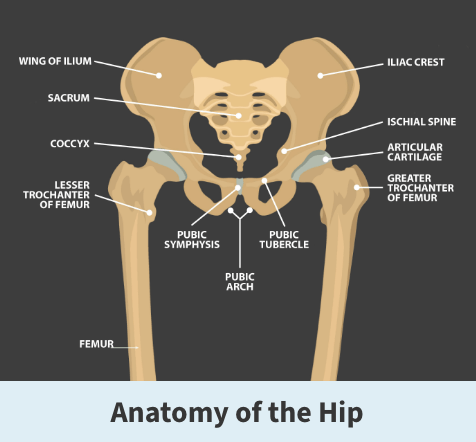Hip avascular necrosis
Osteonecrosis
Osteonecrosis, also known as hip avascular necrosis, is a condition that occurs when the blood supply to the head of the thighbone is disturbed. Since bone cells need a constant supply of blood to stay in good condition, osteonecrosis can result in the destruction of the hip joint and severe arthritis. This condition develops in stages and gets increasingly more painful as it progresses. There are both surgical and nonsurgical procedure options available and are recommended based on the severity of the condition. Recovery can take anywhere from a few months to more than a year.
Anatomy

The hip joint is a ball and socket joint, where the socket is the large pelvis bone (acetabulum), and the ball is the upper end of the thighbone (femoral head). The thighbone is known anatomically as the femur. The surface of the joint is covered with articular cartilage that protects the bones and enables them to glide smoothly across each other by having a smooth and slippery consistency.
About
Avascular necrosis of the hip, also known as osteonecrosis of the hip, is a condition that occurs when the blood supply to the femoral head is disrupted. The bone cells in your body, specifically the ones in the femoral head, need a steady amount of blood to stay healthy. When they do not get the required blood supply, the hip joint is destroyed over time, leading to severe arthritis.
Osteonecrosis of the hip can affect anyone but is more common in people between the ages of 40 and 65. Men are more susceptible to this disease than women. Additionally, some factors can put you at a higher risk of getting this form of osteonecrosis, including:
- Injury – Hip injuries can potentially cause damage to the blood vessels and affect the blood supply to the femoral head.
- Excessive alcohol use – Overconsumption of alcohol can cause fatty deposits to form in your blood vessels and elevate cortisone levels which can result in a decreased blood supply to the femoral head.
- Corticosteroid medicines – Many diseases, such as asthma and rheumatoid arthritis, are treated with steroid medications, which can potentially lead to osteonecrosis. The exact reason about why this happens is unknown.
- Medical conditions – Osteonecrosis is associated with other diseases such as Caisson disease, sickle cell disease, Crohn’s disease, and vasculitis. Contact your Florida Orthopaedic Institute physician if you have a medical condition that would put you at risk for osteonecrosis.

Symptoms
Osteonecrosis develops in stages. The first symptom is usually hip pain with a dull ache or throbbing pain in your hip joint or buttock area. As the disease progresses, it becomes increasingly difficult to stand and apply weight on the affected hip. Although it may take several months to a year for the disease to progress, it is important to get diagnosed early. Several studies have shown that early treatment leads to better outcomes.
Diagnosis
Your Florida Orthopaedic Institute physician will take a look at your symptoms and medical history to help determine if your pain is originating from the hip joint. To do this, your physician will move your hip in different directions. Your physician will also order various imaging tests to help determine if you have osteoporosis and not a different disease. These tests include:
- X-rays – This test gives your physician images of the dense structures in the body, such as bone.
- Magnetic resonance imaging (MRI) scans – This test helps evaluates how much of the bone is affected by the disease. An MRI can also show early osteonecrosis that has not caused any symptoms yet.
Treatment
There are both surgical and nonsurgical treatments available and are recommended depending on the severity of the condition. To recover from osteonecrosis fully, most people typically need to get surgery.
Nonsurgical treatments
There are a few nonsurgical treatment options available that may be recommended to you, including:
- Bisphosphonates – These are prescription medications that reduce bone loss by destroying cells that contribute to the degeneration of bone which helps to preserve healthy bone tissue. This medication is taken by mouth or injection, depending on the severity of your osteonecrosis.
- Nonsteroidal anti-inflammatory drugs – Common examples of these types of over-the-counter medications are aspirin and ibuprofen. Since osteonecrosis can be painful, these medications reduce inflammation which relieves pain and swelling in your hip.
- Statins – These medications lower cholesterol levels by reducing the amount of fatty substances known as lipids in your bloodstream, which results in more blood reaching the bone, allowing for the reconstruction of the bone tissue. This has the potential to slow or even stop the progression of your osteonecrosis.
- Physical therapy – Physical Therapy with the help of medication may slow down the progression of osteonecrosis while providing some pain relief. On top of physical therapy exercises, your physician may also recommend using crutches or a cane to keep as much weight as possible off the hip.
Surgical treatments
There are several different surgical treatment options available to help you reach a full recovery.
- Core decompression – During this procedure, either a large hole or several small holes are drilled into the femoral head to relieve pressure in the bone and create channels for new blood vessels to reach the affected areas of the hip.
- Osteochondral (bone and cartilage) grafting – This procedure is often combined with core decompression to help regenerate healthy bone and support cartilage at the hip joint. A bone graft takes healthy bone tissue and moves to an area of the body where it is needed. Tissue is taken from either a donor (called an allograft) or from another bone in your body (called an autograft). Additionally, there are several synthetic bone grafts available today that are also used.
- Vascularized fibula graft – During this procedure, a segment of bone is taken from the fibula, the small bone in your leg, along with its artery and vein, which act as its blood supply. Both the bone and its blood supply are moved into a hole created in the femoral neck and head. The artery and vein are reattached to help heal the area of the osteonecrosis.
- Total hip replacement – If your osteonecrosis is severe and has advanced to the point where the femoral head has already collapsed, then you may need a total hip replacement. During this procedure, the damaged bone and cartilage are removed and replaced with new metal or plastic joint surfaces.
Recovery
While recovery time depends on the procedure used and the severity of your osteonecrosis, it is typical that you will be instructed to use crutches or a cane to keep pressure off of the hip. It is also typical to attend physical therapy for as long as a year to ensure a full recovery from osteonecrosis.
Videos
Related specialties
- Anterior Hip Replacement
- Groin Strains & Pulls
- Hamstring Injuries
- Hip Arthroplasty
- Hip Arthroscopy
- Hip Dislocation
- Hip Flexor Strains
- Hip Fractures
- Hip Hemiarthroplasty
- Hip Impingement Labral Tears
- Hip Muscle Strains
- Hip Pointers & Trochanteric Bursitis
- Iliopsoas Tenotomy
- Labral Tears of the Hip (Acetabular Labrum Tears)
- Osteoarthritis of the Hip
- Osteoporosis
- Pelvic Ring Fractures
- Piriformis Syndrome
- Sports Hernias (Athletic Pubalgia)
- Thigh Fractures
- Thigh Muscle Strains
